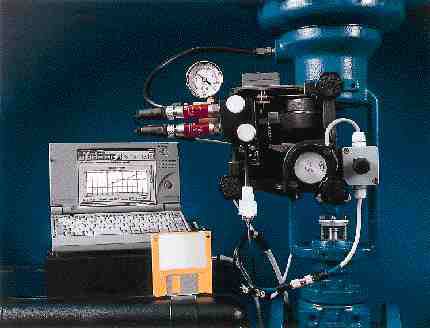
Features
Research & Innovation
Optimizing Control Loop Performance
The pulp and paper industry is under increased pressure to improve manpower productivity and yields. This has lead to mill staffing reductions and efforts to improve control loop performance while ext...
December 1, 1999 By Pulp & Paper Canada
 Evaluating the condition and performance of installed control valves can be achieved with mobile diagnostic systems. Shown is the Neles Automation Nelscope.
Evaluating the condition and performance of installed control valves can be achieved with mobile diagnostic systems. Shown is the Neles Automation Nelscope. The pulp and paper industry is under increased pressure to improve manpower productivity and yields. This has lead to mill staffing reductions and efforts to improve control loop performance while extending intervals between maintenance shutdowns.
This, in turn, leads to an interesting dilemma. While optimal control loop performance has never been more critical, the available manpower to work on loop optimization and the windows of opportunity to shut down the process for this purpose have never been smaller. The controls industry has responded by providing the industry with new electronic technologies and services related to control valve operating conditions and performance.
Studies conducted by EnTech Control Inc., Toronto, ON, have determined that nearly 80% of the control loops in pulp and paper mills actually contribute to increased process variability. Although there are many underlying causes, more than half directly involve control valves (30% inadequate valve maintenance and 30% poor loop tuning).
The control valve package is the only moving mechanical device in the control loop and is the most likely element to wear and change. Therefore, adopting a strategy that optimizes the performance of control valves over their full life cycle is a critical step in maximizing mill profitability.
Control valve performance testing and diagnostic services and digital positioners are just a few of the services and tools available that help mills pinpoint and prepare for the most critical valve maintenance and process improvement tasks during scheduled shutdowns. Maximum process loop improvement can be realized in spite of minimum manpower availability and time resources. In addition, costs are reduced because valves are not pulled off line for unnecessary maintenance.
Diagnostic services
In the future, all valve positioners will be digital and most control valve monitoring and diagnostics will be performed remotely. Today, however, the vast majority of installed positioners are analog, which means that control valve package performance and diagnostic information must be captured at the actual control valve through testing.
Evaluating the condition and performance of installed control valves can be achieved with mobile diagnostic systems. Current systems are capable of testing multiple control valves with analog positioners in a single day without requiring the valve to be removed from the line.
Mobile diagnostic systems include standardized test programs, such as ISA calibration, dynamic hysteresis, step response, frequency response, deadband and manual bump/sensitivity, generally provide a thorough characterization of the control valve’s condition and control element performance. Certain software programs also make it possible to write customized tests to satisfy the special requirements of a particular mill.
Scope of service
Testing and diagnostic services should include the following components:
Defining which control valve packages need to be assessed prior to the shutdown.
Determining if the current control valve package is sufficiently robust for current process requirements.
Performing diagnostic and performance tests on critical valves to assess maintenance requirements for the valve package and how well the valve package as a whole is contributing to the minimization of process variability.
Recalibrating and adjusting the actuator and positioner as problems are detected.
Trained technicians must visually inspect critical valves at the plant to determine which ones are the most likely candidates for service many weeks in advance of a planned shutdown. Diagnostics should be performed on these and other valves approximately one month before an annual shutdown. During the diagnostic tests, the technician must assess performance of the positioner, service if necessary, and calibrate it to assure the best possible performance and control accuracy without having to remove the valve from the line.
The digital future
Digital technology significantly improves the efficiency with which both diagnostics and performance data are collected from control valve packages. Intelligent positioners have microprocessors that not only improve the accuracy and speed of response to the control signal, but also automatically collect performance and diagnostic data. This data can be accessed locally or remotely, either directly or through an internet/intranet connection. Today’s digital technology allows for automatic monitoring of control valve performance and can even send warnings to an e-mail address or to a digital mobile phone when a valve is no longer performing optimally. Identifying performance changes as soon as possible after a change occurs is key to minimizing process variability.
Print this page